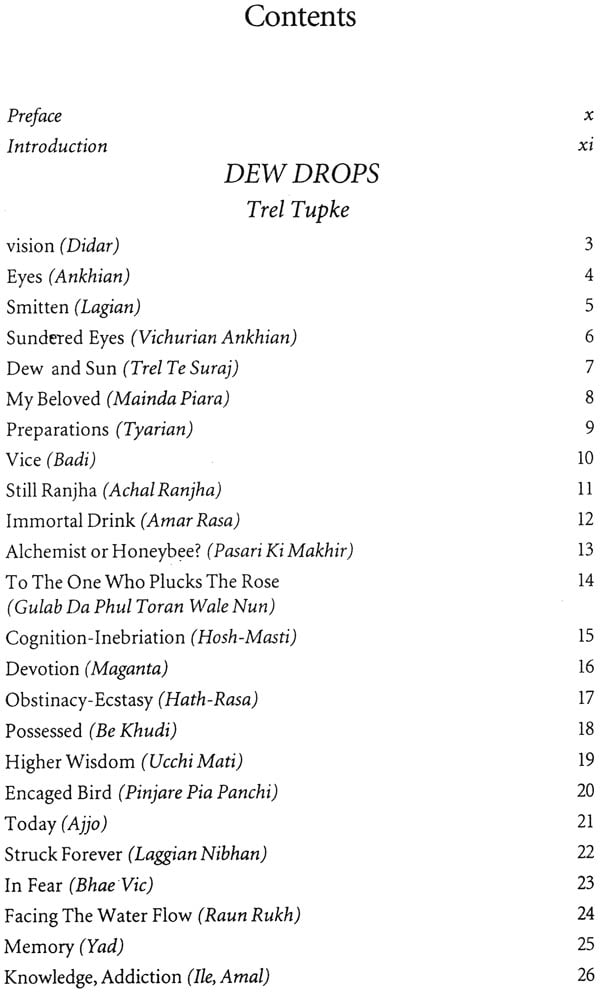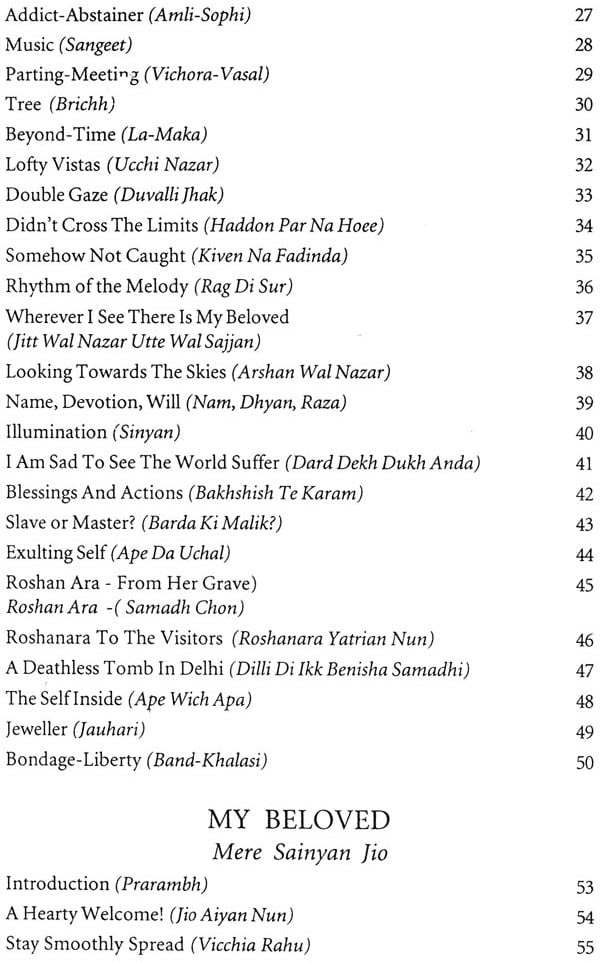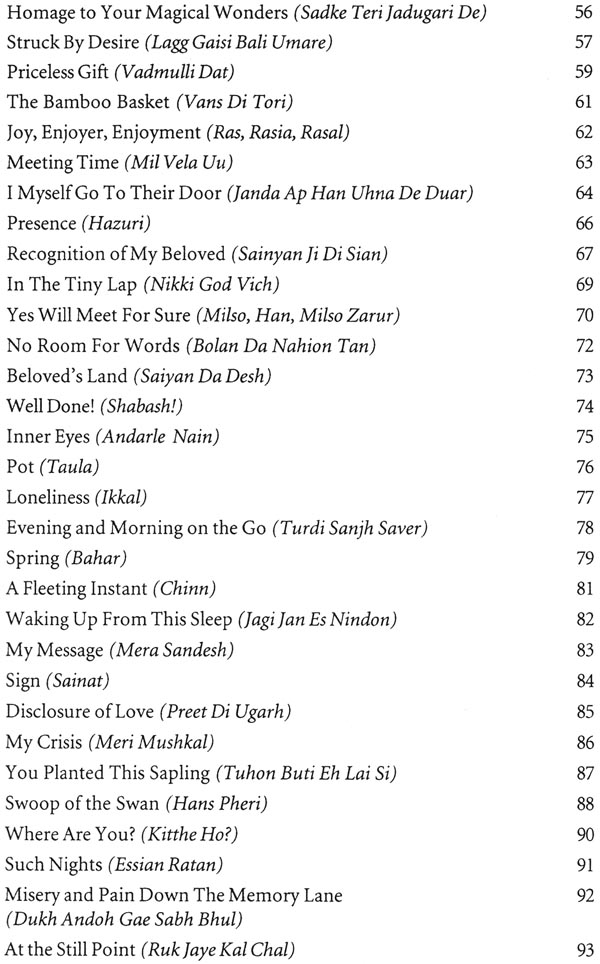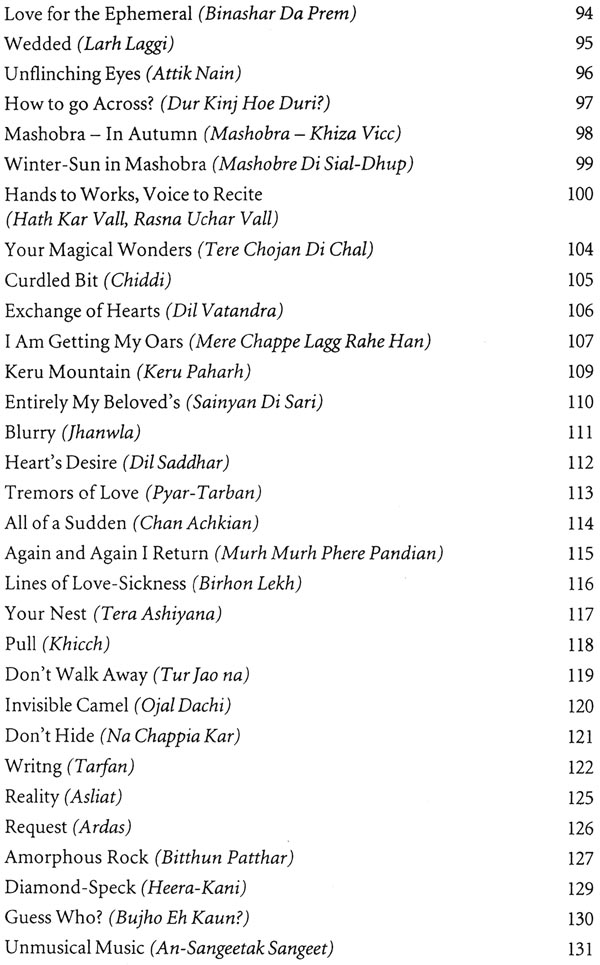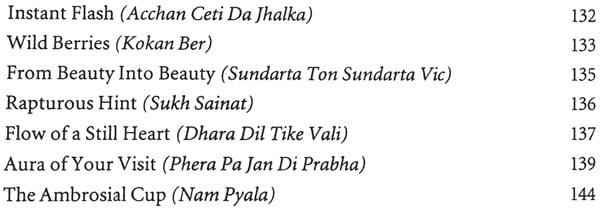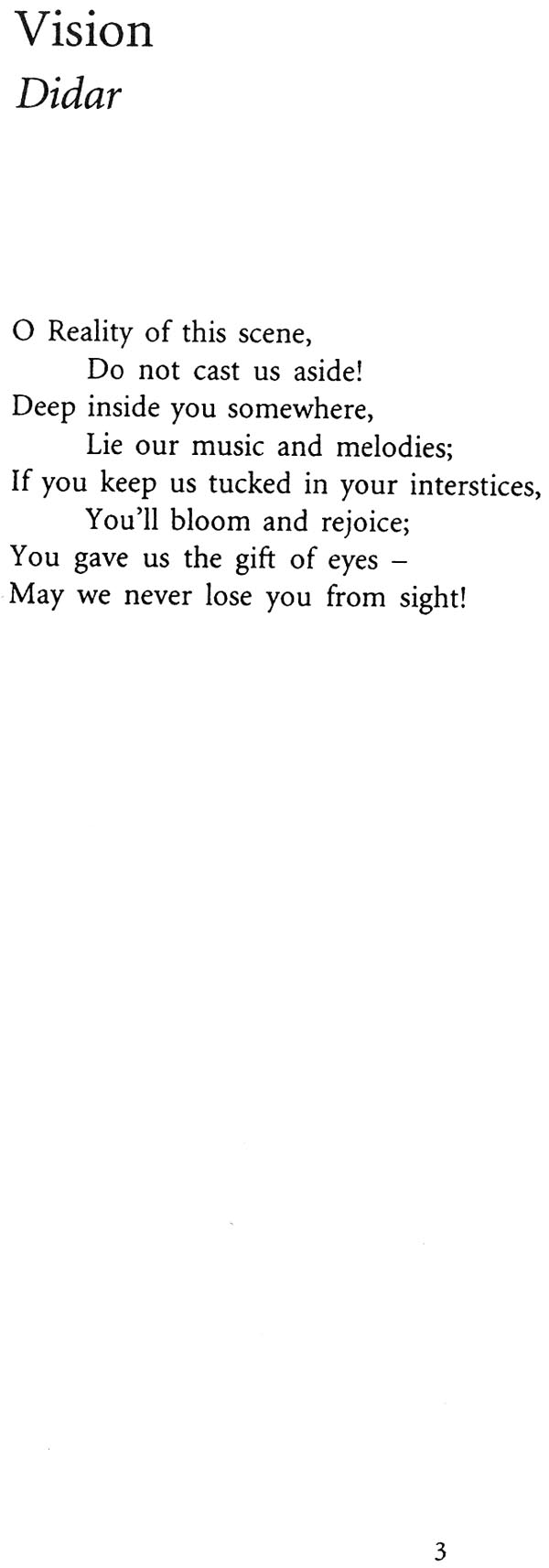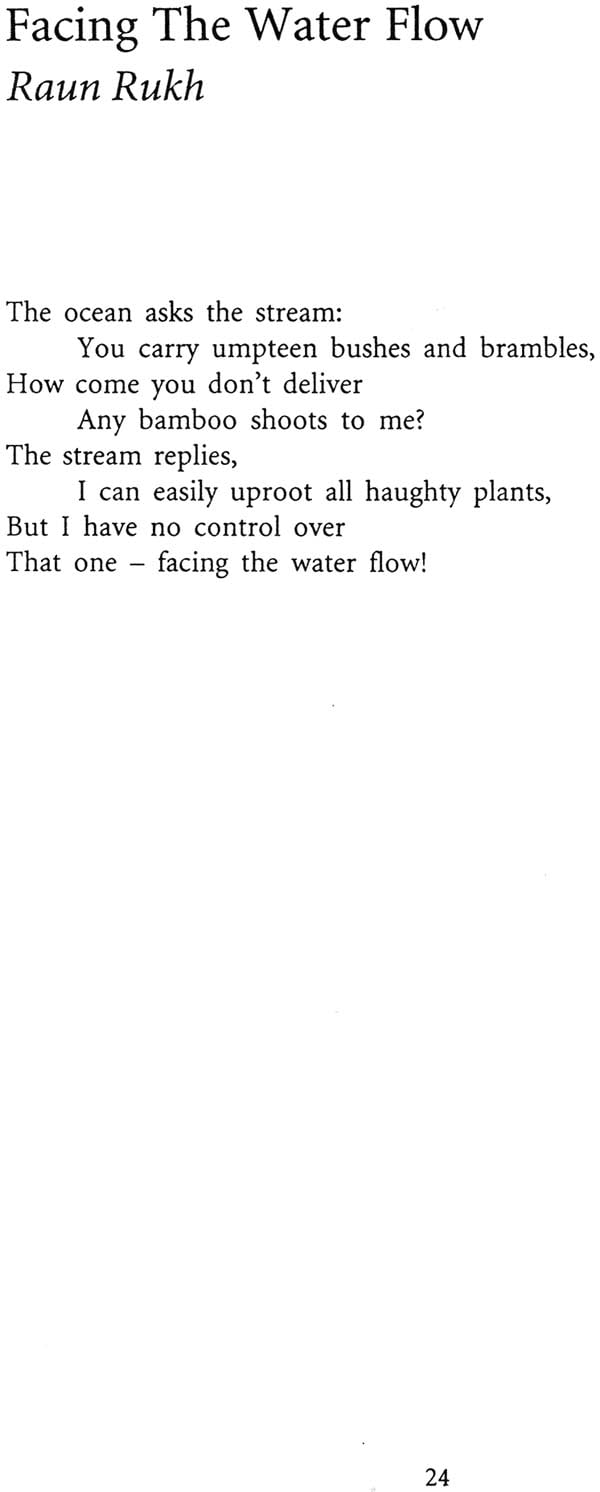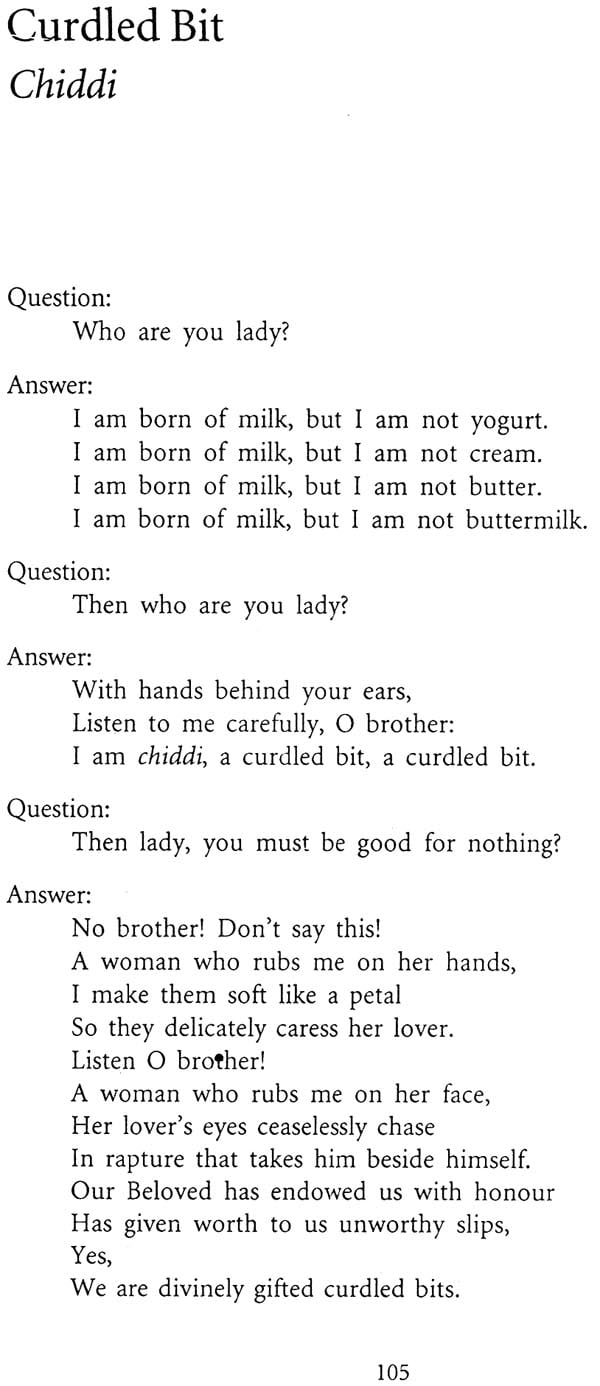
Cosmic Symphony (The Early and Later Poems of Bhai Vir Singh)
Book Specification
| Item Code: | NAR259 |
| Author: | Nikky-Guninder Kaur Singh |
| Publisher: | SAHITYA AKADEMI, DELHI |
| Language: | English |
| Edition: | 2010 |
| ISBN: | 9788126025411 |
| Pages: | 174 |
| Cover: | PAPERBACK |
| Other Details | 8.50 X 5.50 inch |
| Weight | 230 gm |
Book Description
This present volume brings together Bhai Vir Singh’s early and final lyrical pulsations in the English language. Trel Tupke (Dew Drope) launched his poetic career; Mere Sainyan Jio (My Beloved) was the culmination of his poetic development. The images and themes important to Bhai Vir Singh early on in life replaying amazing beauty in his final poetic discourse. Together, they provide valuable insights into the poet’s vast psychological and mystical world.
Not only do these collections help us understand the poet’s mental kaleidoscope, but they also impact the reader’s mind. The short poems draw attention to the nitty-gritties of daily life, including the curdled bits, the dew-drops, the wild berries. Through the profound simplicity of his language and the intensity of his emotions, Bhai Vir Singh bestows a magical quality, transforming ordinary experience into something absolutely extraordinary. His poems have enormous aesthetic power, igniting intellectual vigour and moral responsibility. As we read, our eyes literallyopen to the material phenomena all around us, and utterly fascinated, we begin to desire the infinity, "flitting on forms, they famish for more" (Trel Tupke, 2).
Nikky-Guninder Kaur Singh is the Crawford Family Professor of Religious Studies at Colby College in Maine, USA. Her interest focus on poetic and feminist issues. She has published extensively in the field of Sikhism, including The Birth of Khalsa: A Feminist RE Memory of Sikh Identity, The Feminine Principle in the Sikh Vision of the Transcendent; Skhism Facts on File, and Metaphysics and Physics of the guru Granth Sahib. Her translation of Selections of Sikh sacred poetry The Name of My Beloved: Verses of the Sikh Guru was first published by Harper Collins USA in 1995.
June 10, 2007 marks the 50th death anniversary of Bhai Vir Singh, and this book is my attempt to pay tribute to him. I am very grateful to Colby College for giving me the sabbatical, and to thank the Sahitya Akademi for publishing a work that has been extremely meaningful for me. My special thanks to its Deputy Secretary Gitanjaliji for all her interest and support. Thanks to Dr. Mohinder Singh, Director of the Bhai Vir Singh Sahitya Sadan, for hosting my lectures over the years — the opportunity of being with the family and friends of Bhai Vir Singh has been inspirational for me. Thanks to Sharan Aunty for her love that comes to me in Punjabi across the oceans. And thanks to Bira, Harry and Sarah who in their own different ways help me stay in touch with my inner being where in get to hear those poetic melodies i my mother tongue.
I am profoundly grateful to my father Professor Harbans Singh for exposing me to the great poet. Actually I was quite young when he was doing a book on Bhai Vir Singh for the Sahitya Akademi. We were on our summer holiday in Dehra Dun. My father invariably 'dictated' the first draft of all his books, essays, letters and countless entries, which he would then revise over and over! Since he did not have access to his official secretary in Dehra Dun, I was apprenticed — rather unwillingly on my part — but something of Bhai Vir Singh's poetry and my father's devotion to Punjabi literature seeped into my psyche. Years later, and miles away from the Punjab, my spirit draws upon that rich reservoir — all that I lost comes back to life when I read his verse. There are other links with Bhai Vir Singh as well, which make him an extra special figure for me. His younger brother Dr. Balbir Singh and his niece Dr. Mohinder Kaur were very good family friends, and we shared delightful times both at their home in Dehra Dun and at ours in Patiala. When my brother got married, Dr. Balbir Singh graciously presented him with the pen used by Bhai Vir Singh. I am proud that the Sahitya Akademi has given me this venue to share the flow of his pen with a wide audience.
After twenty years of teaching at Colby College, I took my first full year sabbatical and indulged myself by translating Bhai Vir Singh's poems. And what a wonderful experience it has been! Any poem I would enter, would seem like diving into an unplumbed ocean — where vibrant scenes, elemental sounds, sensuous tastes, sensations and smells churned out of its primordial waters leapt me far up into the boundless skies. How could a tiny lyric have such cosmic force? The poet must have profoundly felt the vibrations of the universe, and somehow, through his artistic talents, gathered them in such a way that made it possible for his readers to hear them. This book is my attempt to make that cosmic symphony available to the English speaking public.
Bhai Vir Singh is known as a 'maker of modern Punjabi literature'. Poet, novelist, editor, exegete, historian and journalist, he was the leading figure in the Singh Sabha, the dynamic Sikh renaissance movement which aspired to revive Punjabi culture. He was born on December 5, 1872 in Amritsar, within a rapidly changing social and cultural milieu. The Sikh kingdom established by Maharaja Ranjit Singh had been lost in 1849, and the Punjab had become part of the British dominion. As Western education and ideology began to circulate over the land of the five rivers, strong currents of both reform and transformation came into play. The Christian missionary activity further raised self-awareness amongst the people. Ironically, westernisation brought about the development of indigenous cultural traditions and the vernacular Punjabi language. Bhai Vir Singh profoundly participated in the exciting cross-currents of modernity and tradition: he attended the Church Mission School, he read English writers and philosophers, he absorbed Western ideas, he broke away from the constricting classical structures and tropes. Simultaneously, he learnt Persian, Urdu and Sanskrit; he went back to his own Indian roots, to his legendary protagonists Heer and Ranjha, to his Sikh heritage and to his mother tongue Punjabi. His literary production is voluminous, and includes eight collections of poetry, four novels, a play, five biographies and numerous texts that he meticulously annotated and commented upon. In different genres he tries to awaken his community to their own past with fresh and innovative insights. He set up a printing press, and even started a weekly newspaper, the Khalsa Samachar, which is still in circulation. Punjabi was his medium, for he understood the powerful link between culture and language, and firmly believed that in order to change the consciousness of his people, he had to communicate with them in their tongue. Bhai Vir Singh's versatile genius modernised the Punjabi language and gave a new life to it as a literary medium. For a detailed discussion of his life and works, and his impact on Punjabi literature, see Professor Harbans Singh's excellent volumes in the Sahitya Akademi Series
Bhai Vir Singh is also known as a 'poet of the Sikhs'. He was born in a family steeped in Sikhism. Both his maternal and paternal grandfathers were scholars of Sikh sacred literature. In fact Giani Hazara Singh (maternal side) was a direct descendant of the influential line of exegetes from the time of the tenth Sikh Guru. Giani Hazara Singh was also an inspector of schools in the Church system and prepared some school textbooks in Punjabi by translating Urdu classics. Little Vir Singh who spent a lot of time with his grandfather questioned him one day as to why he only translated other people's books and did not write his own!' No wonder, when he grew up, Vir Singh took up creative writing and wrote volumes and volumes to underscore the metaphysical ideals and ethical values of his Sikh faith. When he was a teenager, he wrote his first novel Sundari - actually the first in the Punjabi language. In the novel, Sikh ethical principles are concretely embodied in its strong and virtuous heroine. Similarly, his epic Rana Surat Singh (modelled on Spenser's Faerie Queene, and longer than 12,000 lines!) presents the quintessence of Sikh mysticism through its female protagonist Rani Raj Kaur. Bhai Vir Singh wrote several biographies on the life of the Sikh Gurus, and a play Raja Lakhdata Singh, which again elucidates Sikh principles. Late in his career, he wrote a formal commentary on the Guru Granth, the Sikh sacred text, which was published posthumously in several large volumes. Furthermore, he revised the Guru Granth Kosh, a dictionary of Sikh scripture, which explains important terms and allusions in great detail. The dominant strand underlying his prodigious output was his use of poetic strategy to evoke, elucidate and expand the Sikh scriptural message. Poetically, Bhai Vir Singh grasped the Guru Granth, and made it diaphanous and alive for his readers. The Sikh poet is a glass (to use Emerson's analogy) through which later generations can see Sikh scripture in all its richness.
In my previous works, I have explored Bhai Vir Singh's usage of artistic strategy tof evoke, elucidate and expand Sikh theological and ethical concepts.
At this point, however, I wish to see Bhai Vir Singh simply as a poet. As Aristotle said, poetry is concerned with the universals and so I feel we must not limit the poetic legacy of Bhai Vir Singh to the Sikhs. Its universal notes reach out to all of us across religions and continents. In this volume, entitled Cosmic Symphony: The Early and Later Poems of Bhai Vir Singh, I have translated two of his poetic works — Trel Tupke AND Mere Sainyan Jio. Though poetry was the blood throbbing in his veins constantly, these two texts mark the beginning and the culmination of Bhai Vir Singh's poetic development. Trel Tupke is renowned as his first collection of lyric poems. Written after 1909, it was first published in 1922 and brought out as part of the collection Lehran de Har (Garlands of Waves) in 1928. The collections Matak Hulare, Bijlian de Har, Preet Veena AND Kant Maheli followed in quick succession. An anthology of songs in praise of the Sikh Gurus was published in 1933 under the title of Kambdi Kalai (The Trembling Wrist). Mere Sainyan Po (My Beloved) in 1953 was the last collection of verse that Bhai Vir Singh published.
The style of the short poem that we find in Trel Tupke AND Mere Sainyan Po was an innovation in Punjabi literature and became popular instantly, gaining a large audience outside the religious circle. While ushering new and quicker lyric tunes and measures into Punjabi prosody, the short poem introduced new words and images as well. Romantic poets like Wordsworth and Keats had their impact, and the new form brought about a revolutionary transformation in Punjabi poetry. Sadly, in spite of his phenomenal inspiration and the intrinsic beauty of his verse, I am amazed that much of Bhai Vir Singh's poetry is not available to the English speaking public. We have a few extracts from his poems, but no poetic book in its entirety. Even a work like Mere Sainyan Jio, which won the Sahitya Akademi Award in 1955, has not received a complete English translation till this present work.
The task of translating his powerful verse from the original Punjabi into English is of course daunting. We all know Robert Frost's dictum, `poetry is what is lost in translation'. A translation cannot ever replace the original. Indeed it is a challenge to transmit the aesthetic efficacy of taste from one tongue to another. Even eminent scholars who have translated Bhai Vir Singh's poems acknowledge that their translations are not literal but rather ‘transcreations'
The renderings are not all literal but, in a sense, are ‘transcreations'. In view of the wide gap between the principles of expression in the Punjabi and English languages, in some places lines have been, so to say, 'telescoped' and the essence rather than the detailed expanse of the poet's theme attempted. This has sometimes been rendered particularly necessary by the poet's tendency towards prolixity. A *more detailed rendering would perhaps be found to lose point and significance in English.
I, to the contrary, found his colloquial style refreshingly familiar, and therefore relatively easy to translate. It seems to me that if we try to stay as close as possible to the original verse, and follow its movements, rhythms and syntax, Bhai Vir Singh's Punjabi verse lends itself quite well to English. In fact in this instance Walter Benjamin's thesis that 'Languages are not strangers to one another, but are, a priori and apart from all historical relationships, interrelated in what they want to express' rings true.
It is however absolutely necessary that the translator sincerely respect both languages — equally. Without the essential parity between the original and the receptor languages, we cannot have any meaningful translations. As Pannwitz remarks, 'Our translators have a far greater reverence for the usage of their own language than for the spirit of the foreign works. Indeed, the imperial English language with its own set of meanings, connotations and structures has dominated our globtrtinised world, and in the process of translation, a language like Punjabi has been totally subservient to His Master's Voice. But with a genuine regard for both languages, the translation from the text to the adaptation follows accurately and smoothly without much tension. Punjabi and English may be from different cultural, temporal and geographical contexts, but when a translator approaches them as equal and parallel entities, they affirm each other, voice each other, enrich each other and even tenderly embrace each other. In this translation project I realised the authentic affinity between Punjabi and English.
**Contents and Sample Pages**
